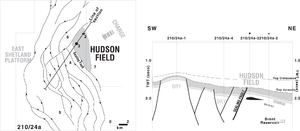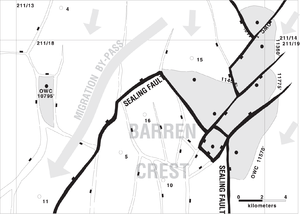How faults control trap fill and migration pathways
| Exploring for Oil and Gas Traps | |

| |
| Series | Treatise in Petroleum Geology |
|---|---|
| Part | Predicting the occurrence of oil and gas traps |
| Chapter | Evaluating top and fault seal |
| Author | Grant M. Skerlec |
| Link | Web page |
| Store | AAPG Store |
A sealing fault can trap hydrocarbons but also will act as a barrier for hydrocarbon migration into traps beyond that fault. In addition, faults can act as baffles by deflecting hydrocarbons along migration pathways that may not be perpendicular to structural contours.
Controlling trap fill
Dry traps, or traps with limited fill, may exist because hydrocarbons have been trapped downdip along sealing faults. A fault can act as a barrier to (1) all hydrocarbons or (2) some of the hydrocarbons, allowing a limited volume to migrate. It can also act as a barrier along part of the fault plane and as a conduit along other parts of the fault plane.
Controlling migration
Where complex fault systems exist between a trap and a source kitchen or between two traps, migration pathways are correspondingly complex. Traps in this setting can have widely different migration/fill or charge risks, depending upon fault seal behavior.
Migration parallel to faults
Where the dip of carrier beds is not perpendicular to faults, even cross-leaking faults can act as barriers as long as the permeability of the carrier bed is higher than that of the fault. Hydrocarbons can then migrate parallel to a fault rather than across the fault, even though the fault cross-leaks. This baffle effect can direct hydrocarbons away from potential traps as well as toward others. Migration pathway maps are critical to prospect assessment.
Example: Hudson field

The Hudson field, North Sea, is an excellent example of how faults control migration pathways and charge.[1] The map and cross section in Figure 1 show that the first well, 210/24a-l, was located on the crest of an obvious structural high. This well encountered water-wet Brent Group sandstones. A second well on the flank, 210/24a-2, encountered oil shows suggestive of a local stratigraphic trap. Thirteen years after the initial well, the 210/24a-3 well discovered the Hudson field: a fault-dependent trap.
The sealing fault trapped hydrocarbons in a flank fault compartment and prevented hydrocarbons from migrating into the more obvious structural high to the west. Predrill fault seal analysis and a migration pathway map would have correctly identified the sealing fault and would have placed a much greater risk on the success of the first well. In this case, new seismic data identified the sealing fault; however, numerous examples exist where the same error is made with high-quality seismic data. Hydrocarbons do not simply migrate into the crest of structural highs.
Example: Don field

In the Don field, North Sea (Figure 2), sealing faults prevent hydrocarbons from migrating into fault compartments on the crest of a large structural high.[1] Instead, hydrocarbons are trapped in several fault compartments on the flank of the structure against cross-sealing faults that have sand/sand juxtapositions. Wells in three fault compartments (211/18-5, 10, and 16) in the crest of the structure are dry. Hydrocarbons have either been trapped downflank or have been deflected to the southwest by sealing faults.
See also
- Fault seal and migration pathways
- How to construct migration pathway maps
- Effect of seal on hydrocarbon yield estimates
References
- ↑ 1.0 1.1 1.2 1.3 Hardman, R. F. P., and J. E. Booth, 1991, The significance of normal faults in the exploration and production of North Sea hydrocarbons, in A. M. Roberts, G. Yielding, and B. Freeman, eds., The Geometry of Normal Faults: London, Geological Society of London, p. 1–16.